Life at the Lake
a diary of living at a small lowland lakeWHAT IT'S LIKE
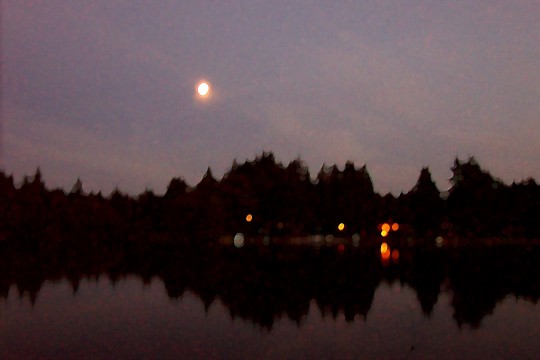
Early moonrise over Lake Ketchum
|
Archive Search |
| Links |
|
and s-integrator |
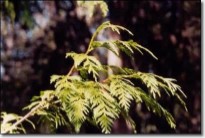
Graceful bough of the cedar
Of all the trees that grow in the West, I think the Western Red Cedar might be considered the holiest—if there is such a thing among trees. I should like to think there is.
Presently the cedar is dropping both reddish leaves and tiny cones that grow in clusters near the tip of the bough. Since I am nearly surrounded by mature specimens of this wonderful tree, there are days when it seems not so wonderful, not so holy. It leaves a mess beneath. But then I mentally slap myself on the wrist, or forehead, and tell myself that I am wrong to have such thoughts. I sweep my my walks and decks repeatedly. The tree is simply undergoing its seasonal changes. Fall is at hand, and soon it will be winter.
The tree grows large and resembles a redwood or even a sequoia. In fact it may be considered a redwood indigenous to the Pacific Northwest. Indians revered it and made their long-lasting canoes out of its wood, hollowing out the trunk first with fire, then with chisels and, later in time, with chainsaws.
My house is built of Western Red Cedar, and I am both proud of it, the material used, and ashamed, because the tree grows so stately and tall. I believe that the really old giants need to be preserved; they are readily hunted by timber poachers in ultra-remote areas of the rainforest West. In my front yard is a single specimen that must be nearly four feet in diameter. And I must admit that passing in front and then behind it, as I often do, several times a day, gives me a cathedral-like experience that I cherish.
I love that tree!
- - Comments ()
...
Evidently Hurricane Isabel is causing such havoc on the East Coast that blog traffic is down considerably. You could say the blog is a bog. So we will put off our regular considerabable effort for today and wish BlogStudio.com good luck in returning to normal traffic by tomorrow.
Life here at the lake continues to remain good, with gray skies, practically no wind, and light scattered rains.
Good luck to you in the East, and our wishes for you, Let There Be Light. Especially electricity to run your computers and search the Internet.
- - Comments ()
...
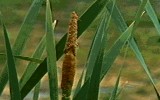
That familiar long cone is really the cattail's flower and is comprised of thousands of tiny seeds
I've been digging up cattails. For the first time. Whew! What a job. They resist me at every step, or rather at every shovel full.
Cattails are a native plant, here and in many parts of the world. This makes them environmentally okay, but they are invasive, which means they have a mind of their own and will take over your shoreline (and everybody else's) if you don't periodically do something about them.
They are a tough critter. I've watched them inch forward by the yard from the East, where my neighbor, an absentee landlord (yes, we've got these, even in the country) does a minimum of yard or property maintenance each year. And he inherited them from his neighbor to the East. Yearly they spread. I've kept my eye on their rate of progress, and I would reckon it at about ten feet a year.
A couple of years ago we had none, no cattails. I remarked to my wife that, gee, I wish we had some. I like cattails and the way blackbirds nest in them, and blackbirds are the first bird of summer to appear here, so early as February. And as I sleep through winter, my ear is alert for their melodic trill, even though I am pretty deaf in the ear that is usually not buried in the pillow.
But I've got too many cattails, and by next year I will have too many more by ten or twelve feet, losing more of the shoreline I have dedicated to plants forming a land/water buffer. And they grow ten or twelve feet high, blocking my view, and have thick stalks, halting my approach to the water's edge; with the plant community I can, if I have to, part my way through them to the water.
This was a good time of the year to try to remove some of them, with the water as low as it has ever been and much beach apparent. So I began to dig them up, with a five-foot spade. They have a complex and dedicated root structure, the winding, twisting roots often 1-1.5 inches in diameter and firmly entwined in the silt and gravel. It was hard work and slow progress, but I made some, tossing the tall stalks on the beach and later picking up the pile in the big wheelbarrow. To fit them in, I had to bend and nearly break them into thirds. At one end was the root mass, the size of an overly large fist; at the other, the sharp-edged flat long leaves—like a sword.
I hauled away two wheelbarrow loads before, heavily sweated in the late summer sun, I gave up on them. I had cut them back to one-year's growth, I figured. I took them to the community vegetation dump, where by common agreement nothing is put that will not biodegrade in a two-year cycle.
Of course someone (usually the same "someone") cheats on the unspoken "green" rules for the dump, and puts in smashed cement, corrugated plastic, or machine parts. But for the most part it is quickly decaying limbs, leaves, and garden vegetation. With the coming rains it will compress nicely and soon turn to rot.
- - Comments ()
...
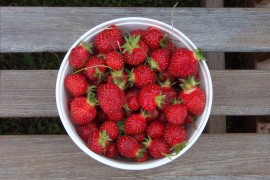
Second crop of strawberries—in September
It is autumn, all right, even though there are a few days yet till the autumnal equinox. Sign: rain, cool nights, and a shift in the duck population.
Yesterday morning about seven common mergansers showed up on the lake; they had the female coloring, which is what the young do till they mature, so it could have been a mixed group.
And in the evening five or six northern shovelers appeared. They are easy to spot, after you've seen a few for years. They are pale—a sort of buff, with blue wing patches (like a mallard) that are visible much of the time they are afloat. And of course they swim with their beaks touching the water, whether or not they are scooping up algae or waterweed. Ours were not.
In the morning they were gone, but they will return, I am certain. And I have no idea where they've been, all summer.
Meanwhile the ever-bearing berries perpetuate. Strawberries' first crop was in June, which is traditional around here. Raspberries the next month. Then a hiatus. In August straws- and rasps- began bearing again, perhaps not quite so abundantly, but still a good crop; the straws- first, and now the rasps- are just passing their peak.
Off the dock yesterday a rainbow trout of about a pound. It had an odd coloring—odd, that is, until I realized it was in spawning dress. What, in fall? Yes, some of ours are from a hatchery in Eastern Washington, and they are autumn spawners.
I disbelieved my eyes, until the resident fish biologist from the state told me the case. Then I understood what I was seeing, though many of our holdover trout in spring seem dark and read to spawn.
This trout was from this year's plant, and had grown nicely. The speckles and greenish sheen made me think of sea-run cutthroats, and I wondered how much of the cutthroat's coloring was due to the fact that it had entered autumn rivers in order to spawn?
These pretty fall rainbows are a nice surprise, and their bright coloring a bonus.
- - Comments ()
...

Apples and books:
a good combination, these early fall days
The Seattle Times routinely publishes feature articles on persons I've already heard enough about. Last Sunday's fat edition (which is substituted for my favorite daily, The Seattle PI, which it is trying to eliminate through a loophole in the joint operating agreement of twenty years standing) ran an article on Nancy Pearl, who is executive director of Seattle Public Library's Center for the Book.
Whew! What a handle.
I thought I'd like the article and learn something about Pearl and her famed omnivorous reading habits. Instead I learned that "she's read or at least skimmed, all the books" on her list of books in Book Lust, her own book, her first. She must be in her sixties and had the job for years.
"Skimmed"? That's what we do with milk to get rid of the fat content, isn't it?
Later Book Editor May Ann Gwinn adds that Pearl "never lies about a book." No? "She's ruthless. She reads two or three books at a time" [impossible!] "and starts 12 books for every book she gets even fifty pages into. . . ."
In other words, Pearl processes books; they pass across her desk and she gives them an imperial look-see. Some she reads a bit in, others fail the royal scrutiny.
I mean, how do you know what's in a book unless you read it—devote some real time to it? Well, you don't, and as a writer I resent such a dilettante's approach.
There must be a kind of mental osmosis in which, for certain select people, a book's contents are absorbed without reading it, passing off into the mental sorting compartment of the librarian and being pronounced "good, average, mediocre." Rarely, a "great."
Then the book is either bought, promoted, put into circulation, or totally ignored. All without having seriously read it.
How wonderful for us all!
- - Comments ()
...
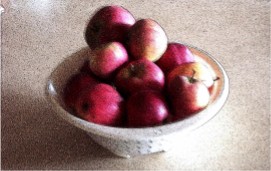
Cool nights bring windfall apples from Paul's
These cold nights, and warm days, are causing apples to ripen and drop to the ground. Though we have only one lame apple tree ourselves (it produces about eight tart green apples each year), next year promises a healthy crop from two small new trees we planted in spring.
In the meanwhile we must do with windfall apples from around the neighborhood. There is an abandoned farm given up on decades ago that has a single roadside apple tree that bears copious insect-ridden apples that fall to the ground long before they are ripe, and we watch it closely each year and try to pick up whatever looks good from the ground before the mice get them.
If I twist one on the tree the classic quarter-turn, it refuses to yield and I pass it by, though I am sure it will fall in a day or two and be partly ruined. But still we wait and watch.
Better yet are Paul's windfall apples, and occasionally he invites us to do a late picking. He lives alone, across the street, and is gone much of the time; he likes to give some apples to his mother, but often forgets. They are presently falling to the ground, nice and red, and the mice are waiting.
Yesterday I helped myself to a small bunch from the ground, leaving to rot further the ones the mice had already nibbled largely. Paul was absent. I hope he can be sighted in a day or two, for I will look longingly in his direction, and hope for an invitation to pick, some or all of his crop.
He has a second and a third tree I have not yet investigated. Probably will today on my dog walk around noon. Good apples there, too.
I just realized that—for the past six years—we have gotten all of our canning apples from his yard. They make great sauce. With a little luck next year, we will have our own trees producing, and they will be wonderful golden-delicious-hybrid eating apples.
Yum-yum!
- - Comments ()
...
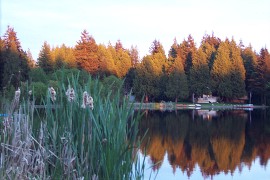
Low lake in early autumn, with cattails in foreground
Ah, the lake. That's what it is all about, isn't it? Life at the lake.
Well, this small lake is now 16 true vertical inches below its winter normal high. That may not seem so much, but it is a great deal. We are experiencing beaches never before seen. They are broad, flat, quite attractive, for when we treated the lake with a herbicide (ugh!) it killed all the weed that normally grew at the interface of land and water, and now it is bereft of weed and grasses.
Yesterday I took the rowboat out to make my last detailed measurements of the year for dissolved oxygen (DO), total phosphorous (TP), chlorophyll, and to take temperatures at various depths. I dropped the anchor in my usual monitoring spot and found slack in the rope, meaning it was less than 5 m. to the bottom. So I up-anchored and moved the boat a few yards to what I thought was more of its deepest location. Same result.
So I took my measurements anyway. What could I do if the lake was too shallow for a 5 m. reading? I tried and struck mud. That would never do. So I took my lowest reading at 4 meters. And my temperature readings there, too.
Back at home, completing the chemistry for DO on my "fixed" samples, I got a respectable reading of 3.25 mg/L, but most years at this time, with the lake higher, I got readings of 0.75 to 1.25 mg/L—not enough to sustain insect or fish life.
So does this mean that, in spite of all-time record of low summer rainfall and above average temperatures, the lake is in better condition than usual? Or does it mean that, nearer the bottom than I could reach, the same dire conditions persist?
Can't say for sure, but the fact that I am again catching scrappy rainbow trout occasionally off my dock is all for the good. And the water temperature at all levels is cooling. Already it is 18 degrees C., when at last reading it was 22 .
And, yes, the nights are refreshingly cooler.
- - Comments ()
...